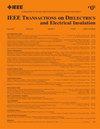Spectral Analysis of Electrical Discharge in Mineral Oil—Comparison With Air Discharge
IF 3.1
3区 工程技术
Q2 ENGINEERING, ELECTRICAL & ELECTRONIC
IEEE Transactions on Dielectrics and Electrical Insulation
Pub Date : 2025-02-13
DOI:10.1109/TDEI.2025.3541615
引用次数: 0
Abstract
This study aims to compare the spectral characteristics of electrical discharges in mineral oil (MO) with those in air. The results demonstrate that electrical discharge channels in MO exhibit a resistive nature, as evidenced by the phase difference, and that discharges in this medium are associated with higher energy levels due to their superior dielectric strength. This necessitates higher voltages for discharge initiation compared to electrical discharges in air, which involve lower energy levels due to air’s lower dielectric properties. Temporal domain analysis shows that electrical discharges in air propagate faster than those in MO. In addition, fast Fourier transform (FFT) analysis reveals that air discharges exhibit a broader spectrum with more high-frequency components, indicating faster propagation than MO discharges. The differences in dielectric properties—such as dielectric strength, breakdown voltage, density, and viscosity—are lower in the air than in MO, significantly influencing discharge characteristics, including current, voltage, power, and energy. These findings offer crucial insights into the nature of discharge channels, energy levels, propagation speeds, and discharge dynamics in air and MO. This contributes to developing more effective insulation monitoring and predictive maintenance strategies in electrical power systems.矿物油中放电的光谱分析——与空气放电的比较
本研究旨在比较矿物油(MO)与空气中放电的光谱特征。结果表明,MO中的放电通道表现出电阻性质,正如相位差所证明的那样,并且由于其优越的介电强度,该介质中的放电与更高的能级相关。与空气中的放电相比,这需要更高的放电电压,由于空气的介电特性较低,空气中的放电涉及较低的能量水平。时域分析表明,空气中的放电比MO中的放电传播更快。此外,快速傅里叶变换(FFT)分析表明,空气中的放电具有更宽的频谱和更多的高频成分,表明比MO中的放电传播更快。在空气中,介电特性(如介电强度、击穿电压、密度和粘度)的差异比在MO中要小,这显著影响了放电特性,包括电流、电压、功率和能量。这些发现对空气和MO中的放电通道、能级、传播速度和放电动态的性质提供了重要的见解。这有助于在电力系统中开发更有效的绝缘监测和预测性维护策略。
本文章由计算机程序翻译,如有差异,请以英文原文为准。
求助全文
约1分钟内获得全文
求助全文
来源期刊
CiteScore
6.00
自引率
22.60%
发文量
309
审稿时长
5.2 months
期刊介绍:
Topics that are concerned with dielectric phenomena and measurements, with development and characterization of gaseous, vacuum, liquid and solid electrical insulating materials and systems; and with utilization of these materials in circuits and systems under condition of use.

 求助内容:
求助内容: 应助结果提醒方式:
应助结果提醒方式:


